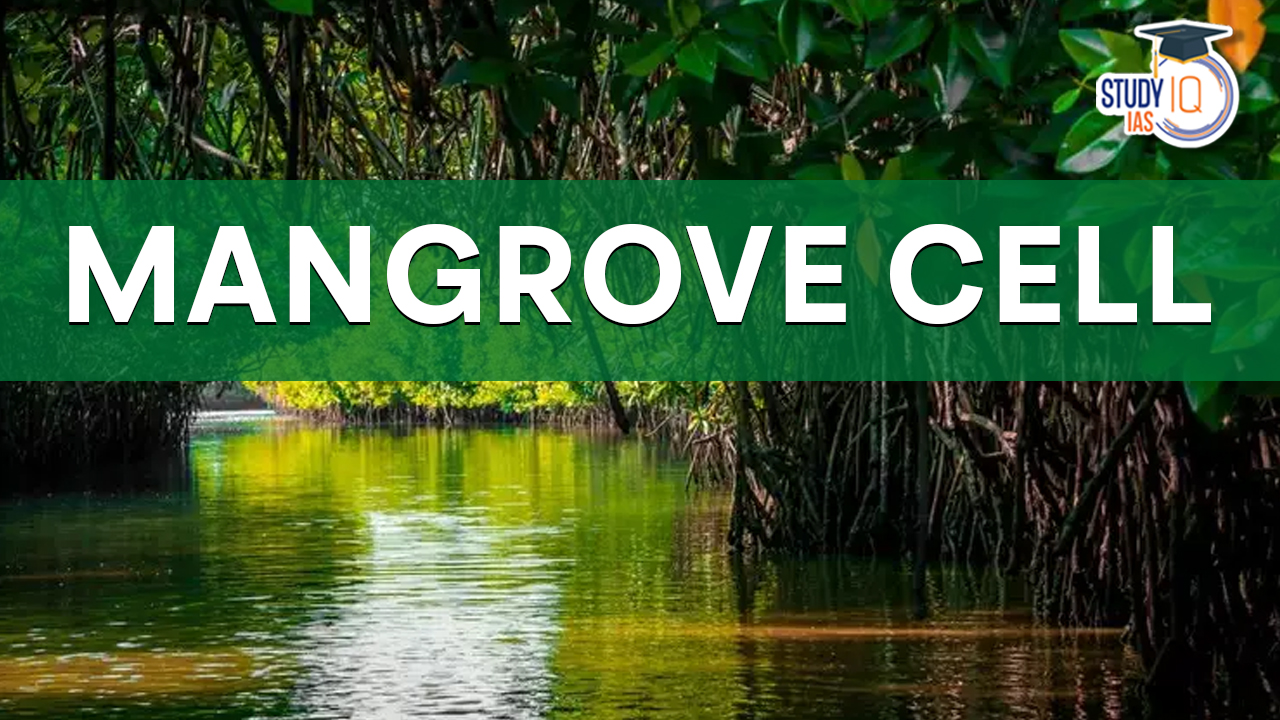Table of Contents
Context: West Bengal has announced the setting up of a ‘mangrove cell’ in the State, on the International Day for the Conservation of the Mangrove Ecosystem.
More on News
- The state of West Bengal is home to about 40% of the mangrove forests in India.
- The Mangrove Cell will be a specialized body that will be solely dedicated for mangrove management and conservation.
- It will have an action plan aimed at planting and maintaining mangroves in the state and will work in coordination with Non-Governmental Organizations (NGOs) to enhance mangrove conservation efforts.
- The cell will generate funds not only from government sources but also from private and international sectors.
About Mangroves
- Mangroves are salt-tolerant plant communities found in tropical and subtropical intertidal regions.
- They are formed when there is intertidal flow and where adequate sediments are available for the trees to set down roots.
- They can survive under extreme hostile environments such as low oxygen conditions.
- The mangrove root system absorbs oxygen from the atmosphere.
- Mangroves have special roots for this purpose called pneumatophores (breathing roots) with pores through which oxygen enters the underground tissues.
- Mangroves, like desert plants, store fresh water in thick succulent leaves and the waxy coating on the leaves seals in water and minimises evaporation.
- They are considered blue carbon ecosystems.
- Blue carbon refers to the carbon stored in coastal and marine ecosystems, such as mangroves, seagrasses, and salt marshes.
- Mangrove tree species: The tree species that form a mangrove forest or ecosystem are broadly classified as true mangroves and mangroves associates.
- True mangroves are the ones which display morphological adaptations for a high saline mangrove ecosystem such as pneumatophores, vivipary or crypto vivipary germination and salt-secreting cells.
- Mangrove associates are plant species that grow in close proximity to mangroves but are not necessarily adapted to life in saltwater environments.

Significance of Mangroves
- Ecological Stabilization: Mangroves serve as a reservoir for waste assimilation, contributing to soil construction and preservation. They offer protection against cyclones and help in land formation, mud bank stabilization, wind energy dissipation, and tidal and wave energy.
- Mangroves and Tides: The complex root systems of mangrove trees enable them to withstand daily tidal changes, making them resilient to the rise and fall of tides.
- Coastal Stabilization: Mangrove forests play a crucial role in stabilizing coastlines, preventing erosion caused by storm surges, currents, waves, and tides.
- Water Purification: Mangroves improve water quality by capturing nutrients from runoff, preventing harmful algal blooms offshore. This purification process is essential for the health and clarity of coral reefs and seagrass habitats.
- Storing Blue Carbon: Mangroves are highly efficient in sequestering carbon dioxide from the atmosphere. Despite covering less than 2% of maritime ecosystems, they contribute to 10-15% of carbon burial, making them crucial in mitigating climate change.
- Supporting Biodiversity: Mangrove ecosystems support a wide variety of organisms, some of which are unique to these habitats. Birds, fish, insects, mammals, and plants find habitat and safety within mangroves.
- Fishery: Mangrove forests are vital for coastal fishing communities as they provide breeding and nesting grounds for fish, shellfish, migratory birds, and sea turtles. It is estimated that mangroves are directly or indirectly responsible for 80% of the world’s fish catch.
- Tsunami Shield: Mangroves act as a natural barrier against tsunamis and storm surges, as they can absorb wave energy effectively. Their extensive root and branch systems help mitigate the destructive impacts of such natural disasters on coastal communities.

India’s Mangrove Cover
- India has about 4,992 sq km (0.49 million hectares) of mangroves, according to the Indian State of Forest Report (IFSR) 2021.
- The IFSR report also points out that India has about 3% of the total mangrove cover in South Asia, and the country’s mangrove cover has increased by 54 square km (1.10%) as compared to the previous 2019 assessment.
- Mangroves in India are distributed across nine States and three Union Territories.
- India’s mangrove cover constitutes 42.45% of West Bengal’s land, 23.66% of Gujarat’s, and 12.39% of the A&N Islands.
- West Bengal (2114 sq km)
- Gujarat (1140 sq km)
- A&N Islands (617 sq km)
- Andhra Pradesh (404 sq km)
- Maharashtra (304 sq km)
- Kerala and Puducherry are the states and UTs with the least mangrove cover.

Stats IQ
- Largest Mangrove Forest: Sundarbans in West Bengal are the largest mangrove forest regions in the world. It is listed as a UNESCO World Heritage Site.
- The forest is home to the Royal Bengal tiger, Gangetic dolphins and Estuarine crocodiles.
- Bhitarkanika Mangroves: The second largest mangrove forest in India is Bhitarkanika in Odisha created by the two river deltas of River Brahmani and Baitarani.
- It is one of the most significant Ramsar wetlands in India.
- Godavari-Krishna Mangroves, Andhra Pradesh: The Godavari-Krishna mangroves extend from Odisha to Tamil Nadu.
- The deltas of the Ganges, Mahanadi, Krishna, Godavari, and the Cauvery rivers contain mangrove forests.
- The backwaters in Kerala have a high density of mangrove forest.
- Pichavaram in Tamil Nadu has a vast expanse of water covered with mangrove forests. It is home to many aquatic bird species.
- West Bengal has 42.45% of India’s mangrove cover, followed by Gujarat 23.66% and A&N Islands 12.39%.
Threats faced by Mangroves
Mangroves face various threats that put their survival at risk:
- Coastal Commercialization: Coastal development, aquaculture, rice and palm oil farming, and industrial activities are encroaching upon and replacing mangrove ecosystems at an alarming rate. These activities are fueled by infrastructure development, urbanization, and agricultural land conversion, leading to the rapid disappearance of mangroves.
- Shrimp Farms: The establishment of shrimp farms has been a major contributor to mangrove loss, accounting for approximately 35% of overall deforestation. The demand for shrimp in international markets, such as the United States, Europe, Japan, and China, has driven the expansion of shrimp farming, often at the expense of mangrove forests.
- Temperature Stress: Mangroves are sensitive to temperature fluctuations. A relatively small variation in temperature can cause significant stress and damage to these salt-tolerant trees. Freezing temperatures, even for a short period, can be fatal for some mangrove species.
- Soil Challenges: The unique soil conditions where mangroves grow pose challenges for their survival. The soil is deficient in oxygen due to frequent flooding, and unlike most plants, mangrove roots cannot easily extract oxygen from gases trapped in the surrounding soil.
- Human Intervention: Mangroves historically had the ability to migrate further inland during changes in sea levels. However, human development now acts as a barrier, restricting the natural migration of mangrove forests. Human activities often disrupt the natural ecological balance of mangrove ecosystems.
- Oil Spills: Mangroves are vulnerable to oil spills, which can have devastating effects on these delicate ecosystems. Oil pollution can lead to long-lasting damage and disrupt the intricate web of life within mangrove habitats.
Conservation of Mangroves
- UNESCO Designated Sites: The inclusion of mangroves in Biosphere Reserves, World Heritage sites, and UNESCO Global Geoparks helps in advancing knowledge, management, and conservation efforts for these vital ecosystems on a global scale. These designations signify the importance of preserving mangroves and their rich biodiversity.
- International Society for Mangrove Ecosystem (ISME): Established in 1990, ISME is a non-governmental organization dedicated to promoting the study of mangroves. Its main objectives are to enhance the conservation, sustainable management, and rational utilization of mangrove forests.
- Blue Carbon Initiative: The International Blue Carbon Initiative focuses on mitigating climate change by conserving and restoring coastal and marine ecosystems, including mangroves. The initiative is a collaborative effort between Conservation International (CI), IUCN, and the Intergovernmental Oceanographic Commission-UNESCO (IOC-UNESCO).
- International Day for the Conservation of the Mangrove Ecosystem: Celebrated on July 26 by UNESCO, this day aims to raise awareness about mangrove ecosystems and advocate for their sustainable management and conservation.
- Mangroves for the Future Initiative (MFF): Developed by IUCN and UNDP, MFF is a unique initiative that encourages investment in coastal ecosystem conservation. It focuses on supporting member nations, including Bangladesh, Cambodia, India, Indonesia, Maldives, Myanmar, Pakistan, Seychelles, Sri Lanka, Thailand, and Vietnam, in their efforts to protect and sustainably manage mangrove forests.
- National Mangrove Committee (India): The Government of India established the National Mangrove Committee in 1976 to advise the government on matters related to the conservation and development of mangroves within the country. This committee plays a vital role in formulating policies and strategies for the protection of mangrove ecosystems in India.


 Nipah Virus (NiV): Structure, Testing Me...
Nipah Virus (NiV): Structure, Testing Me...
 Elon Musk’s America Party: A New Chapt...
Elon Musk’s America Party: A New Chapt...
 India and Trinidad and Tobago: Strengthe...
India and Trinidad and Tobago: Strengthe...





















